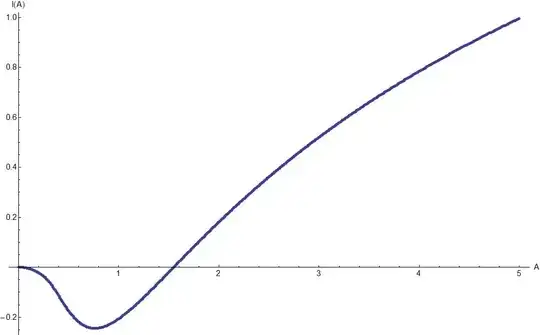In here we derive the result for ${\mathcal I}(A)$. Clearly we have:
\begin{equation}
{\mathcal I}(A) = \left. \frac{d}{d a} J(a,A) \right|_{a=0}
\end{equation}
where
\begin{equation}
J(a,A) := \int\limits_{\mathbb R} \left(1+A \xi\right)^a \frac{e^{-\frac{\xi^2}{2}}}{\sqrt{2 \pi}} d\xi
\end{equation}
Now we compute the quantity ${\mathcal J}$. We have:
\begin{eqnarray}
{\mathcal J}(a,A) &=& \int\limits_0^\infty \left[(1+A \sqrt{2 u})^a + (1-A \sqrt{2 u})^a\right] e^{-u} \frac{d u}{\sqrt{u}} \frac{1}{2 \sqrt{\pi}}\\
&=& \frac{(A \sqrt{2})^a}{2\sqrt{\pi}}
\int\limits_0^\infty \left[(1+\frac{1}{A \sqrt{2 u}})^a + (-1)^a(1-\frac{1}{A \sqrt{2 u}})^a\right]u^{a/2-1/2} e^{-u} du\\
&=& \frac{A^a 2^{a/2}}{2 \sqrt{\pi}} \sum\limits_{n=0}^\infty \binom{a}{n} \frac{1+(-1)^{a+n}}{(A \sqrt{2})^n} \Gamma(\frac{a}{2}+\frac{1}{2}-\frac{n}{2})\\
&=&\frac{(A \sqrt{2})^a}{2\sqrt{\pi}} a! \sum\limits_{n=0}^\infty \frac{1+(-1)^{a+n}}{(A \sqrt{2})^n} \frac{\Gamma(\frac{a+1-n}{2})}{\Gamma(a+1-n)}\\
&=& \frac{A^a 2^{-a/2}}{2 \pi} a! \sum\limits_{n=0}^\infty \frac{1}{n!} (\frac{\sqrt{2}}{A})^n \left(1+(-1)^{a+n}\right) \sin(\pi(a/2+1-n/2)) \Gamma(-a/2+n/2)\\
&=& \frac{a!}{2} (\frac{A}{\sqrt{2}})^a
\left[
\frac{(1+(-1)^a)}{\Gamma(1+a/2)} F_{1,1}\left[\begin{array}{r} -a/2\\ 1/2 \end{array};-\frac{1}{2 A^2}\right] +
\frac{(1-(-1)^a)}{\Gamma((1+a)/2)} \frac{\sqrt{2}}{A} F_{1,1}\left[\begin{array}{r} (1-a)/2\\ 3/2 \end{array};-\frac{1}{2 A^2}\right]
\right]
\end{eqnarray}
The first two steps in the derivation above are self-explanatory. In the third step I used the binomial expansion and integrated term by term using the definition of the Gamma function. In the fourth step I simplified the result and in the fifth step I used the duplication formula for the Gamma function. Finally in the last step I split the sum into a sum over even and odd integers respectively and then used the definition of hypergeometric functions.
Now all we need to do is to differentiate the result at $a=0$ by applying the chain rule. Let us analyze the first term first:
\begin{eqnarray}
\left.\frac{d}{d a} \left[\frac{1}{2} (\frac{A}{\sqrt{2}})^a \cdot (1+(-1)^a) \cdot \frac{\Gamma(1+a)}{\Gamma(1+a/2)}\cdot F_{1,1}\left[\begin{array}{r} -a/2\\ 1/2 \end{array};-\frac{1}{2 A^2}\right]\right]
\right|_{a=0} = \\
\frac{1}{2} \log(\frac{A}{\sqrt{2}}) \cdot 2 \cdot 1 \cdot 1 + \\
\frac{1}{2} \cdot (\imath \pi) \cdot 1 \cdot 1 +\\
\frac{1}{2} \cdot 2 \cdot (-\gamma) \cdot 1 +\\
\frac{1}{2} \cdot 2 \cdot 1 \cdot \frac{1}{2 A^2} F_{2,2}\left[\begin{array}{rr} 1& 1 \\ 2 & 3/2\end{array};-\frac{1}{2 A^2}\right]
\end{eqnarray}
The second term is easier to analyze since there will be only one non-zero term. We have:
\begin{eqnarray}
\left.\frac{d}{d a} \left[\frac{1}{2} (\frac{A}{\sqrt{2}})^{a-1} \cdot (1-(-1)^a) \cdot \frac{\Gamma(1+a)}{\Gamma((1+a)/2)}\cdot F_{1,1}\left[\begin{array}{r} (1-a)/2\\ 3/2 \end{array};-\frac{1}{2 A^2}\right]\right]\right|_{a=0}=\\
\frac{1}{2} (\frac{A}{\sqrt{2}})^{-1} \cdot (-\imath \pi) \cdot \frac{1}{\sqrt{\pi}} \cdot F_{1,1}\left[\begin{array}{r} 1/2\\ 3/2 \end{array};-\frac{1}{2 A^2}\right]
\end{eqnarray}
This finishes the proof.
Update: Below i just attach a piece of code in Mathematica that demonstrates that the result is indeed correct. See below:
A = RandomReal[{0, 10}, WorkingPrecision -> 20];
NIntegrate[
Log[1 + A t] Exp[-t^2/2]/Sqrt[2 Pi], {t, -Infinity, Infinity},
Exclusions -> {-1/A}, WorkingPrecision -> 20]
Log[A/Sqrt[2]] + I Pi/2 - EulerGamma/2 +
1/(2 A^2) HypergeometricPFQ[{1, 1}, {2, 3/2}, -1/(2 A^2)] -
I Sqrt[Pi]/(Sqrt[2] A) Hypergeometric1F1[1/2, 3/2, -1/(2 A^2)]


